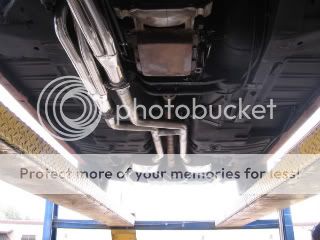Varilux
Well-known member
The ignition gremlins seem to have been sorted- for now- so I thought I'd move on to the exhaust. This time, however, I wanted to get advice here before I order anything.
Currently, I have a '68 exhaust manifold with a single 2" exhaust (the only part that is 1.75" is at the manifold outlet).
My goal is to install a dual exhaust that will utilize the GT trumpets / valence (have the valence painted and ready to go). After researching Classic Inlines, reading through the paperback on hopping up Ford 6cyls (think its called "Falcon 6 Performance" or something), and conferring with the shop that will be installing the exhaust, this is the plan (open to critique).
Header = Classic Inlines dual out header in stainless steel (the kit- with the black oxide studs and gasket)
Exhaust = custom fabbed 1.75" dual pipes (with an "x pipe") (shop wants to use 2"- but I understand the 1.75" will not be restrictive and may sound better)
Mufflers = Magnaflows (recommended by the shop)
The shop recommended getting the headers- but letting them fab the exhaust from the headers back, because "it takes more time to adjust a kit than it does to fab up a custom system." I've had a number of people locally recommend the shop's work. The stickiest part of the job (IMO) is going to be alteration of the A/C bracket. I have the compressor on top with the alternator on the bottom, and the compressor will need to move out 2-3".
Going with the Scott Drake trim rings and tips through the valence.
My 200 is +0.040 over with a mild cam, with a rebuilt Autolite 1100 carb, and DUI ignition (that still needs to be recurved). Its mated to a 5 speed manual with a 3.20 in the differential.
Any suggestions before I place the order for the header would be greatly appreciated. I'm going to put a couple hundred of miles on the car the next week or so (just to make sure I'm happy with the way the "bang" is working), then I'll look forward to getting her breathing a bit better.
Currently, I have a '68 exhaust manifold with a single 2" exhaust (the only part that is 1.75" is at the manifold outlet).
My goal is to install a dual exhaust that will utilize the GT trumpets / valence (have the valence painted and ready to go). After researching Classic Inlines, reading through the paperback on hopping up Ford 6cyls (think its called "Falcon 6 Performance" or something), and conferring with the shop that will be installing the exhaust, this is the plan (open to critique).
Header = Classic Inlines dual out header in stainless steel (the kit- with the black oxide studs and gasket)
Exhaust = custom fabbed 1.75" dual pipes (with an "x pipe") (shop wants to use 2"- but I understand the 1.75" will not be restrictive and may sound better)
Mufflers = Magnaflows (recommended by the shop)
The shop recommended getting the headers- but letting them fab the exhaust from the headers back, because "it takes more time to adjust a kit than it does to fab up a custom system." I've had a number of people locally recommend the shop's work. The stickiest part of the job (IMO) is going to be alteration of the A/C bracket. I have the compressor on top with the alternator on the bottom, and the compressor will need to move out 2-3".
Going with the Scott Drake trim rings and tips through the valence.
My 200 is +0.040 over with a mild cam, with a rebuilt Autolite 1100 carb, and DUI ignition (that still needs to be recurved). Its mated to a 5 speed manual with a 3.20 in the differential.
Any suggestions before I place the order for the header would be greatly appreciated. I'm going to put a couple hundred of miles on the car the next week or so (just to make sure I'm happy with the way the "bang" is working), then I'll look forward to getting her breathing a bit better.

